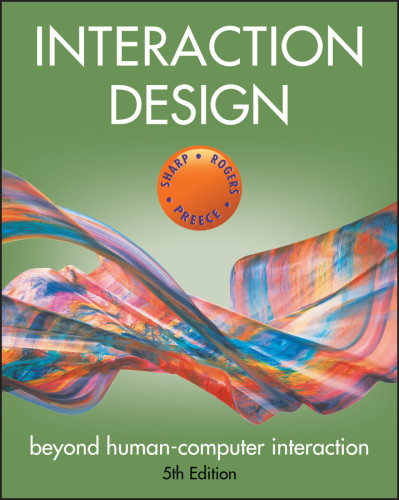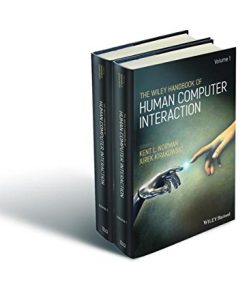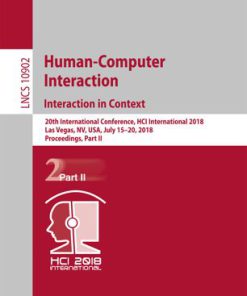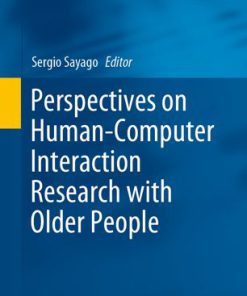Interaction Design Beyond Human Computer Interaction 5th Edition by Helen Sharp, Jenny Preece, Yvonne Rogers 0128053909 9780128053904
$50.00 Original price was: $50.00.$25.00Current price is: $25.00.
Interaction Design Beyond Human Computer Interaction 5th Edition by Helen Sharp, Jenny Preece, Yvonne Rogers – Ebook PDF Instant Download/DeliveryISBN: 0128053909, 9780128053904
Full download Interaction Design Beyond Human Computer Interaction 5th Edition after payment.

Product details:
ISBN-10 : 0128053909
ISBN-13 : 9780128053904
Author: Helen Sharp, Jenny Preece, Yvonne Rogers
Hugely popular with students and professionals alike, the Fifth Edition of Interaction Design is an ideal resource for learning the interdisciplinary skills needed for interaction design, human-computer interaction, information design, web design, and ubiquitous computing. New to the fifth edition: a chapter on data at scale, which covers developments in the emerging fields of ‘human data interaction’ and data analytics. The chapter demonstrates the many ways organizations manipulate, analyze, and act upon the masses of data being collected with regards to human digital and physical behaviors, the environment, and society at large.
Interaction Design Beyond Human Computer Interaction 5th Table of contents:
Chapter 1: WHAT IS INTERACTION DESIGN?
1.1 Introduction
1.2 Good and Poor Design
1.3 What Is Interaction Design?
1.4 The User Experience
1.5 Understanding Users
1.6 Accessibility and Inclusiveness
1.7 Usability and User Experience Goals
Further Reading
Chapter 2: THE PROCESS OF INTERACTION DESIGN
2.1 Introduction
2.2 What Is Involved in Interaction Design?
2.3 Some Practical Issues
Further Reading
Note
Chapter 3: CONCEPTUALIZING INTERACTION
3.1 Introduction
3.2 Conceptualizing Interaction
3.3 Conceptual Models
3.4 Interface Metaphors
3.5 Interaction Types
3.6 Paradigms, Visions, Theories, Models, and Frameworks
Further Reading
Chapter 4: COGNITIVE ASPECTS
4.1 Introduction
4.2 What Is Cognition?
4.3 Cognitive Frameworks
Further Reading
Chapter 5: SOCIAL INTERACTION
5.1 Introduction
5.2 Being Social
5.3 Face-to-Face Conversations
5.4 Remote Conversations
5.5 Co-presence
5.6 Social Engagement
Further Reading
Chapter 6: EMOTIONAL INTERACTION
6.1 Introduction
6.2 Emotions and the User Experience
6.3 Expressive Interfaces and Emotional Design
6.4 Annoying Interfaces
6.5 Affective Computing and Emotional AI
6.6 Persuasive Technologies and Behavioral Change
6.7 Anthropomorphism
Further Reading
Chapter 7: INTERFACES
7.1 Introduction
7.2 Interface Types
7.3 Natural User Interfaces and Beyond
7.4 Which Interface?
Further Reading
Chapter 8: DATA GATHERING
8.1 Introduction
8.2 Five Key Issues
8.3 Data Recording
8.4 Interviews
8.5 Questionnaires
8.6 Observation
8.7 Choosing and Combining Techniques
Further Reading
Chapter 9: DATA ANALYSIS, INTERPRETATION, AND PRESENTATION
9.1 Introduction
9.2 Quantitative and Qualitative
9.3 Basic Quantitative Analysis
9.4 Basic Qualitative Analysis
9.5 Which Kind of Analytic Framework to Use?
9.6 Tools to Support Data Analysis
9.7 Interpreting and Presenting the Findings
Further Reading
Chapter 10: DATA AT SCALE
10.1 Introduction
10.2 Approaches to Collecting and Analyzing Data
10.3 Visualizing and Exploring Data
10.4 Ethical Design Concerns
Further Reading
Chapter 11: DISCOVERING REQUIREMENTS
11.1 Introduction
11.2 What, How, and Why?
11.3 What Are Requirements?
11.4 Data Gathering for Requirements
11.5 Bringing Requirements to Life: Personas and Scenarios
11.6 Capturing Interaction with Use Cases
Further Reading
Chapter 12: DESIGN, PROTOTYPING, AND CONSTRUCTION
12.1 Introduction
12.2 Prototyping
12.3 Conceptual Design
12.4 Concrete Design
12.5 Generating Prototypes
12.6 Construction
Further Reading
Chapter 13: INTERACTION DESIGN IN PRACTICE
13.1 Introduction
13.2 AgileUX
13.3 Design Patterns
13.4 Open Source Resources
13.5 Tools for Interaction Design
Further Reading
Chapter 14: INTRODUCING EVALUATION
14.1 Introduction
14.2 The Why, What, Where, and When of Evaluation
14.3 Types of Evaluation
14.4 Evaluation Case Studies
14.5 What Did We Learn from the Case Studies?
14.6 Other Issues to Consider When Doing Evaluation
Further Reading
Chapter 15: EVALUATION STUDIES: FROM CONTROLLED TO NATURAL SETTINGS
15.1 Introduction
15.2 Usability Testing
15.3 Conducting Experiments
15.4 Field Studies
Further Reading
Chapter 16: EVALUATION: INSPECTIONS, ANALYTICS, AND MODELS
16.1 Introduction
16.2 Inspections: Heuristic Evaluation and Walk-Throughs
16.3 Analytics and A/B Testing
16.4 Predictive Models
People also search for Interaction Design Beyond Human Computer Interaction 5th:
borrow interaction design beyond human computer interaction
interaction design beyond human-computer interaction 5th edition pdf
interaction design beyond human-computer interaction pdf
interaction design beyond human-computer interaction 6th edition pdf
interaction design beyond human-computer interaction 4th edition pdf
Tags: Interaction Design, Human Computer, Interaction, Helen Sharp, Jenny Preece, Yvonne Rogers
You may also like…
Computers - Computer Science
The Handbook of Formal Methods in Human Computer Interaction Benjamin Weyers
Computers
New Directions in Third Wave Human Computer Interaction Volume 2 Methodologies Michael Filimowicz
Computers - Computer Science
The Role of Psychological Reactance in Human Computer Interaction Patrick Ehrenbrink
Computers
New Directions in Third Wave Human Computer Interaction Volume 1 Technologies Michael Filimowicz
Arts - Architecture












